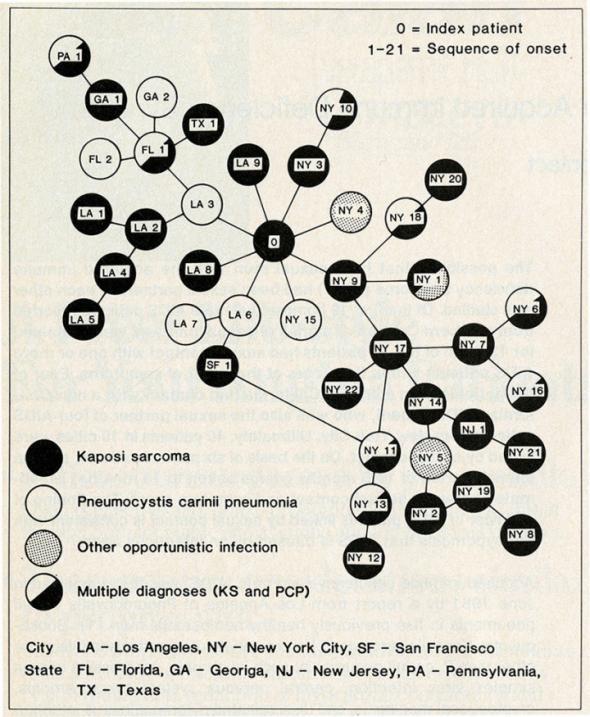Nature published a buzzy new study on Wednesday that, among other things, debunked the popular theory that the “Patient Zero” of AIDS in North America was a French Canadian flight attendant named Gaëtan Dugas. The main point of the paper was to use genome sequencing to assess which strain of HIV first entered the continent and when. Along with doing that, the 10-member team of researchers also sequenced Dugas’ viral genome to determine where he fit in the timeline and whether his infamy was warranted. The answer was a definitive no: Dugas, the team noted, carried a strain quite typical of other strains in America at the time—biologically contradicting the theory that he was the originator of the virus on this continent.
The study is complex, clever, and fascinating. It asks relevant questions about the origin of AIDS in this country that should be assessed scientifically. But bringing Dugas into it is entirely unnecessary. The notion that Dugas was Patient Zero has already been thoroughly debunked—for one thing, the evidence that he was the first North American patient with AIDS was never based on science to begin with. Indeed, we have long known that he only earned the title through a transcription error: In 1984, the Centers for Disease Control and Prevention drew a diagram of HIV case clusters. Dugas was marked Patient O, for Outside of California. But because he happened to be drawn at the center of one cluster, CDC personnel read Patient O as Patient 0, i.e., the first AIDS patient in America. The moniker stuck and the myth took off, becoming conventional wisdom when Randy Shilts profiled Dugas as Patient Zero in his AIDS history And the Band Played On. Ever since, Dugas has been maligned as a modern day Typhoid Mary—but worse, because he ostensibly spread his disease through sexual activities that many Americans considered immoral.

The CDC’s AIDS cluster diagram. The O in the center represents Dugas—but it stood for Outside of California, not Patient Zero.
National Institutes of Health
Patient Zero, then, is a myth and always has been. As scientists pointed out as early as 1988, the timing never made sense: Even if the CDC’s diagram had labeled Dugas 0 for Patient Zero, its analysis would have been incorrect, because the study in question inaccurately measured the development of the virus. (In counting backward to identify a rough date of infection, the CDC alleged that several patients in the diagram had developed AIDS within 11 months of HIV infection. In reality, HIV typically takes five to 10 years to progress into AIDS in an untreated patient.) Whoever brought AIDS to the United States—and it doesn’t much matter who did—it was not Dugas. So why did 10 esteemed scientists feel the need to go back again and debunk this known myth?
At heart, the study is focused on the team’s brilliant methodology and cutting-edge genome sequencing. The techniques it employs in order to assess degraded serum samples seem worthwhile and may allow us to gain a more precise understanding of the spread of the epidemic. The research methods refined and described in the paper will surely be of use to HIV/AIDS researchers today.
And, sure, if they were already running all these tests on all these samples, it is not that much extra work to track down Dugas’ sample and analyze it, too. But we are at the point where we ought to ask whether it is truly necessary to include Dugas, even with the goal of exonerating him. He has already been exonerated. Furthermore, the mistakes that caused Dugas to be blamed for AIDS were not science-based. Do we really need a biologic refutation to what was never a biologic fact?
One unfortunate but eminently plausible possibility is that the study simply needed a hook—to land the paper in a renowned journal, to draw media attention, to break into the news cycle. To be sure, the researchers likely had no ill intent in using Dugas to draw attention to their study. But the effects of their decision are regrettable. Patient Zero is, and has always been, a moralizing and homophobic narrative used to pin the blame of AIDS on homosexual promiscuity. The Patient Zero story puts outsized importance on the role of gay men in the AIDS crisis, and seems to blame them for the sudden outbreak of the epidemic. It frames the spread of AIDS as a morality tale, complete with heroes and villains, assigning culpability to the men who spread the virus through sex. Of course, these men could not know that they were carrying a virus that scientists had not yet discovered. Today we recognize the folly of this narrative. But the Patient Zero narrative brings us right back to the 1980s, when many Americans believed that that gay men somehow brought AIDS upon themselves by engaging in fundamentally aberrant and immoral behavior.
It was thus somewhat disturbing to see Patient Zero splash across the headlines last week, in a number of high-profile articles that often forgot to mention that Dugas had already been exonerated. (The Wall Street Journal’s write-up declared that “A new genetic analysis may settle a longstanding debate over how the nation’s AIDS outbreak started”—when, in fact, the debate over Dugas ended long ago, and the origins of America’s AIDS outbreak remain a mystery.) At this point, evoking the Patient Zero myth only to debunk it once again feels counterproductive: It extends the lifespan of an idea that has long been used to justify homophobia under the thin veneer of “science,” and it puts attention on the first AIDS patient as though finding and blaming him is somehow important. The team behind the Nature study may have legitimately important insights into the science of HIV genome sequencing. They shouldn’t feel compelled to tie their findings to a story that perpetuates a toxic conception of HIV and moral culpability.
